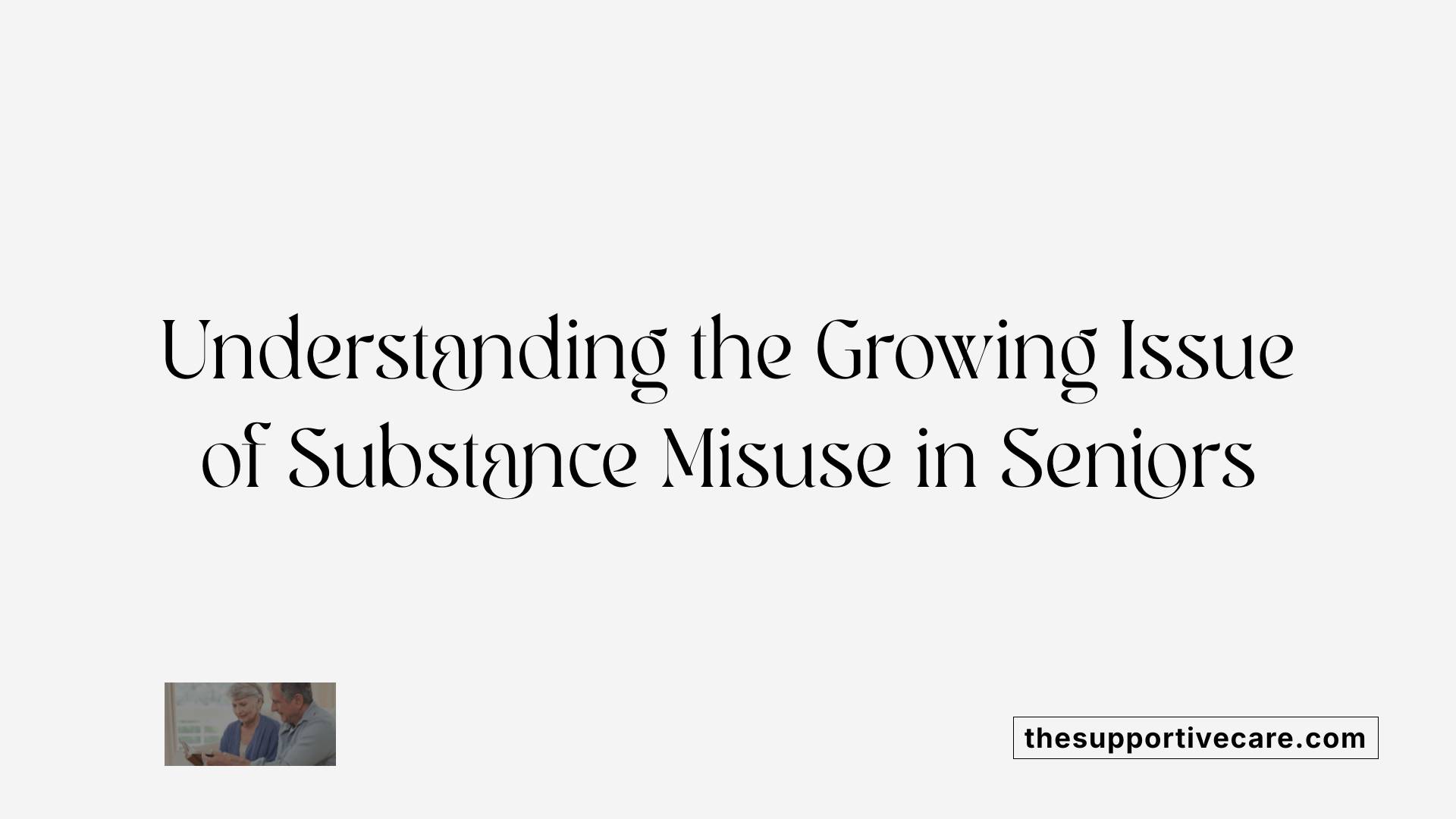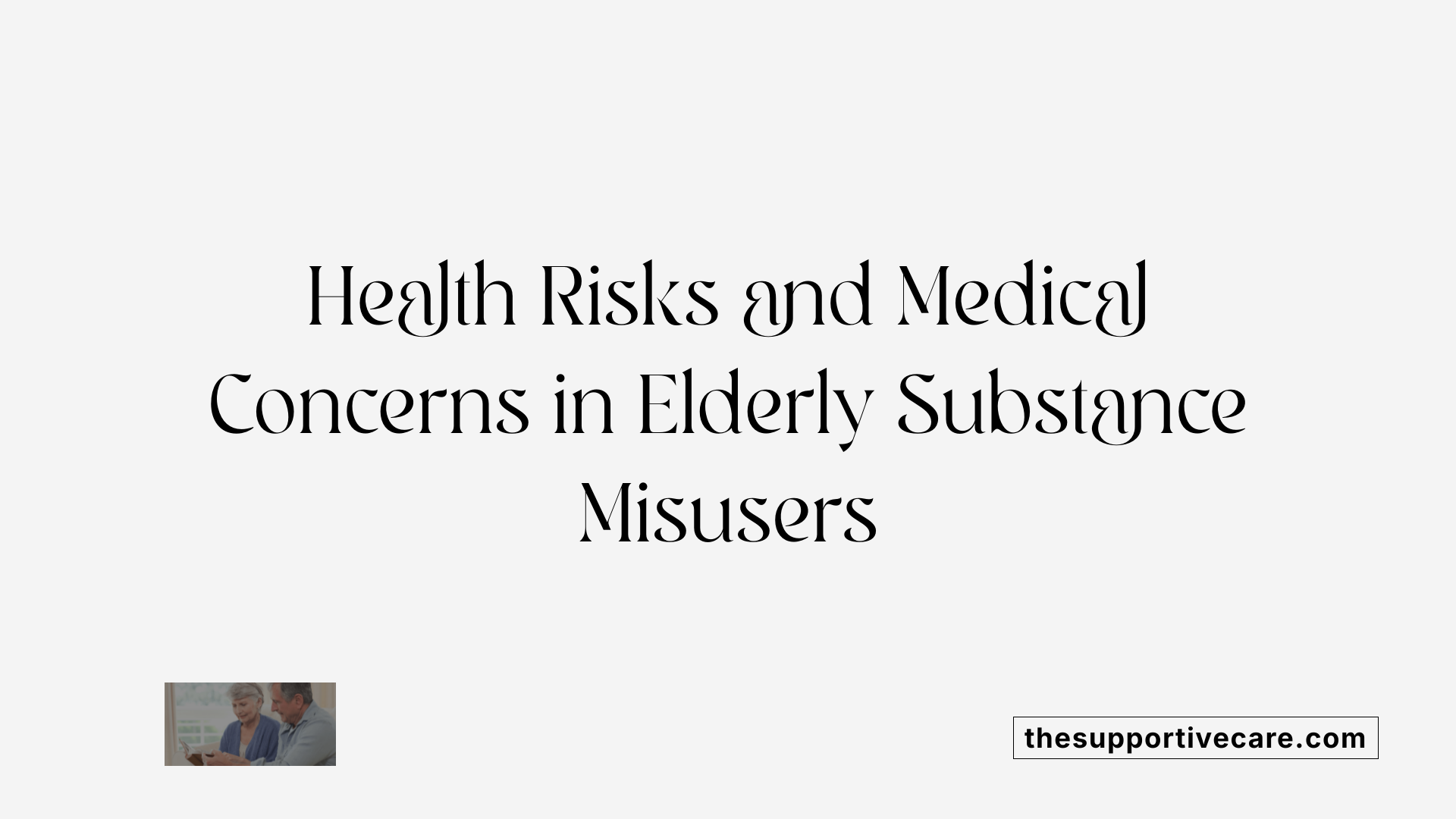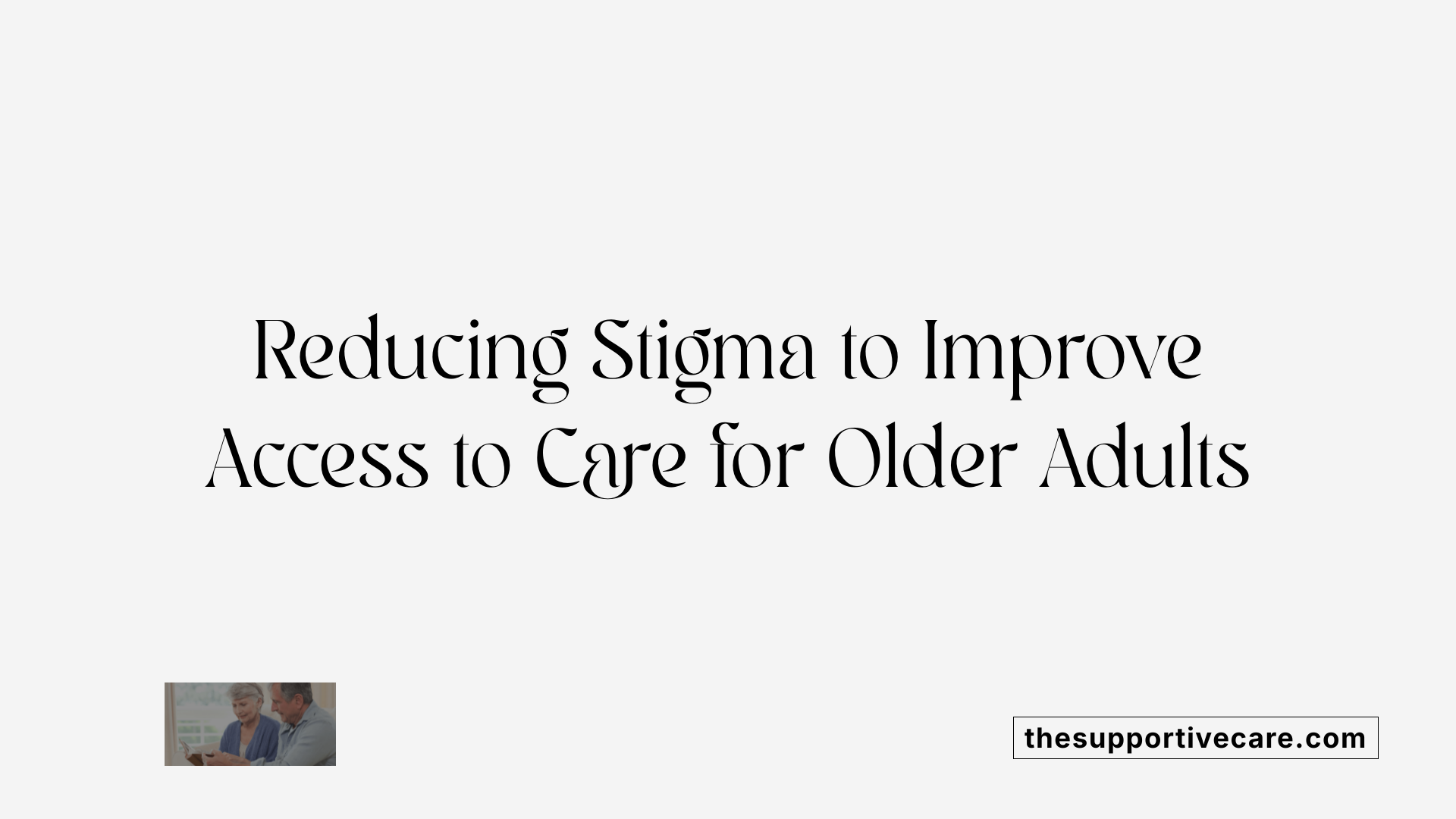Introduction to Substance Use Challenges in the Elderly
Substance misuse among aging populations has become an increasingly pressing health concern. As medical advances extend life expectancy, older adults are experiencing higher rates of alcohol and drug use, often leading to complex health, social, and psychological issues. Recognizing the signs and effectively addressing substance use disorders (SUDs) in this demographic is crucial for improving health outcomes and quality of life. This article explores the prevalence, risk factors, screening methods, clinical signs, challenges, treatment options, emerging trends, and best practices for healthcare providers and community members dedicated to supporting elder populations.
Prevalence and Risk Factors of Substance Misuse in Older Adults
 Substance misuse among older adults is an increasingly significant public health issue. Recent data indicates that in 2022, about 1 in 11 adults over 60 lived with a substance use disorder (SUD). The most commonly misused substances are alcohol and cannabis, with alcohol being the leading choice among this age group.
Substance misuse among older adults is an increasingly significant public health issue. Recent data indicates that in 2022, about 1 in 11 adults over 60 lived with a substance use disorder (SUD). The most commonly misused substances are alcohol and cannabis, with alcohol being the leading choice among this age group.
The prevalence of substance misuse in older populations has risen notably over the past decade. For instance, alcohol use disorders among those aged 65 and older increased by over 100% between 2001 and 2013. Additionally, cannabis use has surged, up approximately 75% from 2015 to 2018, driven partly by medical legalization and changing societal attitudes.
Various factors contribute to this upward trend. Life transitions such as bereavement, retirement, and social isolation can trigger increased substance use as coping mechanisms. Chronic health conditions, pain, sleep disturbances, and mental health issues like depression and anxiety are common among older adults and can lead to self-medication with alcohol or drugs.
Physiological changes with aging play a crucial role. Reduced liver function, increased drug sensitivity, slower metabolism, and increased absorption of substances heighten risks of toxicity and adverse effects. These changes not only amplify the potential for overdose but also increase the likelihood of interactions with existing medications.
Social influences and stigma also impact prevalence. Older adults often face underdiagnosis and undertreatment due to outdated stereotypes, lack of routine screening, and reluctance to discuss substance use openly. Many do not realize that symptoms like confusion, falls, or mood changes might signal substance misuse.
Risk factors for developing problematic use include a history of previous substance issues, chronic pain, mental health disorders, and social factors such as loneliness and loss of loved ones. Men tend to abuse alcohol more frequently, while women are more likely to misuse prescription medications.
Overall, rising trends underscore the importance of increased awareness, routine screening, and tailored interventions. Evidence-based treatments like cognitive-behavioral therapy and motivational interviewing can be effective when adapted for older adults, helping to address their unique needs and barriers.
This evolving landscape calls for a comprehensive approach involving healthcare professionals, families, and community resources to mitigate risks and support older adults in achieving healthier aging.
| Aspect | Data | Additional Information |
|---|---|---|
| Prevalence in 2022 | 1 in 11 adults over 60 | Growing trend, underdiagnosed |
| Common substances | Alcohol, Cannabis | Significant rise in cannabis use |
| Age-related changes | Reduced liver function, increased sensitivity | Heightens toxicity risk |
| Main risk factors | Bereavement, retirement, health issues | Also social isolation and stigma |
| Treatment approaches | CBT, motivational interviewing | Need edition for older adults |
| Future outlook | Increasing prevalence | Necessity for awareness and screening |
Understanding these patterns and factors is essential to develop effective prevention and treatment programs tailored for the aging population, ensuring better health and quality of life for older adults.
Identifying Signs and Symptoms of Substance Misuse in the Elderly

How can healthcare providers recognize signs and symptoms of substance misuse in older adults?
Healthcare providers play a vital role in detecting substance misuse among older adults. They should watch for behavioral signs such as social withdrawal, decline in personal hygiene, sudden mood swings, and increased irritability or hostility. Physical indicators are equally important; these include unexplained injuries, bruises, frequent falls, memory lapses, speech difficulties, and confusion.
Older adults may exhibit signs of intoxication, such as slurred speech, impaired coordination, or unusual drowsiness. Withdrawal symptoms like insomnia, agitation, or anxiety can also be symptoms of underlying substance issues. Particularly in this age group, tolerance to medications might increase, prompting dosage changes that could exacerbate health risks.
To effectively identify at-risk individuals, healthcare professionals should utilize screening tools validated for older populations. Instruments such as the Alcohol Use Disorders Identification Test-Consumption (AUDIT-C), the Michigan Alcohol Screening Test-Geriatric Version (MAST-G), and the Caregiver-Administered Rx Substance Use Screening (CARET) are practical methods for early detection.
Consideration of the patient’s medical history is critical—especially recent increases in alcohol or drug consumption, recent hospitalizations, or reports of social isolation and bereavement. Evaluating medication use, potential drug interactions, and the use of prescribed or over-the-counter substances helps in building a comprehensive understanding.
Integrating these screening procedures into routine assessments at health visits ensures early recognition of problematic use. Prompt identification enables timely interventions, reducing the risks of falls, cognitive decline, overdose, and other health complications associated with substance misuse in older adults.
Challenges and Barriers in Addressing Substance Use in Older Adults

What are the common challenges and barriers in addressing substance use issues among older adults?
Tackling substance use in the elderly comes with many hurdles. Societal stigma and personal shame often prevent older adults from openly discussing their substance use, leading to underreporting and missed diagnoses. Healthcare providers may not routinely screen for substance misuse, partly due to a lack of training or awareness of how common the problem is in this age group.
Physiological changes that occur with aging make detection and treatment more complicated. Reduced liver and kidney function heighten sensitivity to alcohol and medications, increasing the risk of dangerous interactions and adverse reactions. Many older adults have multiple chronic conditions and are on numerous prescriptions, which can mask symptoms or be mistaken for age-related cognitive decline.
Furthermore, the availability of specialized, age-specific treatment programs is limited. Older adults often do not have access to services tailored to their unique needs, and existing programs may not be adapted for cognitive or physical limitations.
The healthcare system itself presents obstacles, including regulatory restrictions, insufficient integration of addiction treatment with primary health care, and logistical issues such as transportation or mobility limitations. Overall, these barriers hinder early identification, intervention, and ongoing support.
Addressing these challenges involves increasing awareness, implementing routine screening protocols, developing targeted treatment options, and fostering a more accepting environment that encourages older adults to seek help without fear of judgment.
Screening Methods for Detecting Substance Use in Older Adults
What screening methods are available to detect substance misuse in the elderly?
Healthcare providers have several validated screening tools to identify substance misuse among older adults. The SMAST-G (Short Michigan Alcoholism Screening Test-Geriatric Version) is specifically designed for this age group and evaluates alcohol-related issues across physical, emotional, and social domains. Its questions consider factors like changes in drinking habits and impacts on daily life.
Other recommended instruments include the AUDIT-C, which assesses alcohol consumption patterns quickly and effectively. The CUDIT-R is used to screen for cannabis-related problems, while the CRAFFT is a brief tool aimed at identifying alcohol and drug use risk, particularly in primary care settings.
The ASSIST-LITE scoring system offers another method by evaluating the level of risk across various substances, including prescription medications, illicit drugs, and alcohol. This approach helps determine whether further assessment or intervention is needed.
Routine screening recommendations
Regular screening for substance misuse should be an integral part of health visits for older adults. It is advised to conduct these assessments at least once a year, especially during annual check-ups, before initiating new medications, or following incidents such as falls or injuries. Screening is also critical when changes in mental or physical health are observed, as these can be signs of underlying substance issues.
Incorporating quick, validated tools into routine practice allows healthcare professionals to identify at-risk individuals early, facilitating timely intervention and support.
Comprehensive assessments for moderate to severe cases
When screening indicates moderate to severe substance misuse, a detailed evaluation is necessary. This assessment involves medical examinations, psychological testing, and social evaluations to understand the full scope of the individual's substance use and its impact.
A multidisciplinary approach helps develop personalized treatment plans that consider age-related factors, co-occurring disorders, and social circumstances. Such assessments are crucial in guiding effective treatment and in preventing serious health outcomes related to substance misuse.
Health Risks and Medical Considerations in Older Adults with Substance Misuse

How do health considerations and medical issues relate to substance misuse in older adults?
As people age, their bodies undergo physiological changes that significantly influence how they process and react to substances such as alcohol and medications. These changes make older adults more susceptible to the harmful effects of substance misuse.
Aging results in decreased liver function, slower drug metabolism, and increased drug sensitivity, which can cause substances to build up to unsafe levels even with low or moderate use. This heightened sensitivity increases the risk of adverse reactions, overdose, and drug interactions.
Older adults often manage multiple chronic health conditions like diabetes, hypertension, and liver disease. Substance misuse can worsen these illnesses, complicate treatment plans, and lead to additional health issues such as falls, fractures, and cognitive decline.
For example, alcohol interacts with medications for blood pressure and diabetes, amplifying side effects and impairing health. Many common substances like benzodiazepines and opioids can increase the risk of confusion, psychomotor impairment, and falls.
Furthermore, symptoms of substance misuse can overlap with those of age-related health problems, such as forgetfulness or mood changes, resulting in underdiagnosis and delayed treatment.
Addressing these concerns involves careful medical assessments, recognizing the impact of aging on drug responses, and developing personalized treatment strategies. Routine screening during healthcare visits and ongoing support play crucial roles in managing both substance use and concurrent health issues.
By understanding these interactions, healthcare providers can better prevent complications, optimize medication management, and improve overall health outcomes for older individuals experiencing substance misuse.
Effective Intervention Strategies and Treatment Options
What intervention strategies and treatment options are effective for substance misuse in older adults?
Addressing substance misuse in older adults requires a multi-faceted approach that combines thorough screening, personalized care, and social support. Regular screening using adapted tools such as the CAGE-AID, CARET, and AUDIT-C is vital. These tools help identify problematic use early, especially tailored to account for age-related changes and social circumstances.
Once identified, treatment should incorporate medication-assisted therapies when appropriate. Medications like naltrexone, acamprosate, and disulfiram are used to treat alcohol use disorder, while buprenorphine and methadone are options for opioid use disorder. It’s important to choose medications that consider the aging body’s altered metabolism and potential interactions with other drugs.
Behavioral therapies are equally critical. Motivational interviewing and cognitive-behavioral therapy (CBT) are effective in fostering change, especially when adapted to respect older adults’ social norms and life experiences. Family and community involvement enhances support networks and reinforces positive behaviors.
An integrated care approach addresses both medical and psychiatric comorbidities. This coordination ensures that physical health problems, mental health disorders like depression and anxiety, and substance use are treated concurrently, leading to better outcomes.
Support services should be accessible, including helplines like SAMHSA’s National Helpline, which offers confidential referrals to treatment programs that accept Medicare or Medicaid. Tailoring interventions to an older person’s physiological, social, and psychological needs—such as adjusting for chronic pain, mobility issues, or social isolation—is essential.
Overall, combining screening, medication, therapy, and social support within integrated models creates a comprehensive framework for effectively managing substance misuse among older adults. Continuing research and policy efforts are needed to broaden access and adapt services to this growing population.
Recent Trends and Advances in Research on Elderly SUDs
Recent research highlights an increase in the prevalence of substance use disorder (SUD) among older adults, with about 1 in 11 individuals over 60 affected by 2022. The most common substances include alcohol and cannabis, which have seen rising usage rates in this population.
Several factors contribute to this trend. Bereavement, chronic health conditions, social isolation, and a history of substance use play significant roles. Physiological changes associated with aging—such as slower metabolism and increased drug sensitivity—heighten the risks of medication interactions, falls, and cognitive decline.
The strength and availability of cannabis have increased, with its use for medical purposes like pain relief, sleep disturbances, and mental health management becoming more common. Changes in societal attitudes and legalization in various regions have also influenced older adults' perceptions and acceptance of cannabis use.
Research into screening and treatment has advanced, emphasizing the importance of evidence-based assessments tailored for older populations. Tools such as the AUDIT-C for alcohol and CUDIT-R for cannabis help identify problematic use early. Tailored interventions like cognitive-behavioral therapy and motivational interviewing, combined with education and community support, have shown promise in improving outcomes.
Overall, managing SUDs in the elderly requires a comprehensive approach that addresses their unique social, physiological, and psychological needs. Early detection, personalized treatment plans, and increased awareness can lead to better health and quality of life for older adults dealing with substance misuse.
Guidelines and Best Practices for Discussing Substance Use with Older Patients
When addressing substance misuse with older adults, healthcare providers should adopt a respectful and compassionate approach. Recognizing the sensitive nature of this topic, clinicians need to create a non-judgmental environment that encourages honesty and openness.
Using open-ended questions can be particularly effective. For example, asking "How much alcohol do you typically drink?" or "Can you tell me about your use of medications or recreational substances?" allows patients to share their experiences without feeling persecuted. This fosters trust and facilitates more accurate assessment.
Incorporating validated screening tools tailored for older populations, such as the AUDIT-C for alcohol or the CUDIT-R for cannabis, helps accurately gauge problematic use. Regular screening—at least annually—is recommended, especially during health visits, before starting new medications, or when injuries or falls occur.
The focus of the discussion should be on health and safety rather than blame, considering the physiological changes in aging that increase susceptibility to adverse effects. Interventions can include brief counseling, motivational interviewing, or referring patients to specialized programs when needed.
Engaging a patient’s social network, including family or caregivers, can support ongoing treatment and promote safer behaviors. Furthermore, providing educational resources about the risks associated with substance misuse and age-related vulnerabilities enhances awareness and encourages proactive management.
By combining respectful communication, evidence-based screening, and individualized care strategies, healthcare providers can improve detection and support recovery efforts among older adults, ultimately enhancing their health outcomes.
Role of Stigma Reduction and Community Support

How can stigma reduction efforts improve identification and treatment of substance misuse in elder populations?
Stigma around substance use often prevents older adults from disclosing their struggles or seeking help. When societal attitudes stigmatize addiction as a moral failing rather than a medical condition, elders may feel ashamed or afraid of judgment, leading to delayed diagnosis and treatment.
Efforts to reduce this stigma can transform how substance misuse is perceived and managed in older adults. Education campaigns that highlight addiction as a health issue with neurobiological roots can help dismantle harmful stereotypes, fostering understanding and compassion. These campaigns should emphasize that substance use disorders can affect anyone, regardless of age, and that recovery is achievable.
Public awareness initiatives that challenge myths—such as addiction being a sign of weak character—encourage a more accepting environment. When communities are informed, older adults are more likely to seek help early, which improves health outcomes.
Addressing stigma also involves systemic policy changes. Increasing funding for elder-focused addiction services, expanding access to treatment programs, and enacting anti-discrimination laws can remove significant barriers to care.
Training healthcare providers in trauma-informed and culturally sensitive approaches ensures that conversations about substance use are non-judgmental. This supportive environment encourages honest disclosures, facilitating timely interventions.
Overall, reducing stigma not only promotes early detection but also enhances the effectiveness of treatment, helping older adults achieve better health and quality of life.
Conclusion: Towards Better Recognition and Response to Substance Misuse in Older Adults
As the aging population continues to grow, so does the importance of recognizing and effectively managing substance misuse among elders. Early screening, understanding behavioral and medical signs, and overcoming barriers such as stigma and inadequate training are pivotal steps. Healthcare providers, families, and communities must collaborate to foster environments of support, open dialogue, and tailored interventions. Continued research and policy reforms are essential to improve access to age-appropriate treatment options and destigmatize substance use issues in senior populations. With sustained effort and awareness, it is possible to enhance the quality of life for older adults affected by substance misuse and to mitigate its extensive health and social consequences.
References
- Chapter 3—Identifying, Screening for, and Assessing Substance ...
- [PDF] Substance Use in Older Adults: How to Recognize the Signs
- Treating substance misuse in older adults
- Substance Abuse Among Older Adults - PMC
- Tips for Talking to Older Adults About Substance Use
- [PDF] TIP 26 Treating Substance Use Disorder in Older Adults Updated 2020
- Signs of Substance Use in Older Adults - Haven Health
- [PDF] SUBSTANCE USE DISORDER IN OLDER ADULTS
- Substance Abuse in the Elderly



































































































